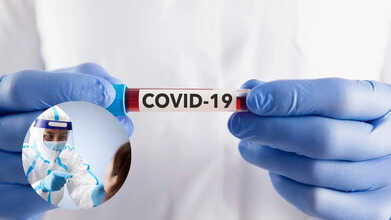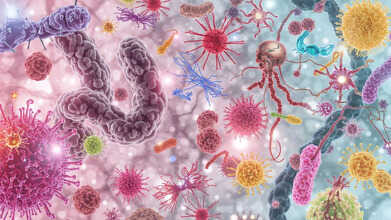- Health Conditions A-Z
- Health & Wellness
- Nutrition
- Fitness
- Health News
- Ayurveda
- Videos
- Medicine A-Z
- Parenting
- Web Stories
What Is Hypersexuality Disorder?

Have you ever felt like sexual thoughts or impulses are taking over, affecting your work, relationships, or daily life? You might have hypersexuality disorder.
It is a condition marked by persistent, excessive sexual thoughts, fantasies, urges, or behaviours that interfere with daily life. It goes beyond having a high sex drive, involving an overwhelming compulsion towards sexual activity that is difficult to control.
What Are The Symptoms?
People with hypersexual disorder may spend hours daily on sexual activities, impacting work or personal responsibilities. They might feel unable to cut back despite harmful consequences, for instance, health risks or relationship issues. People may use sexual behaviour as a way to manage stress, loneliness, or anxiety, often leading to a cycle of guilt and shame.
What Could Be The Consequences?
There may be emotional and social consequences including:
Guilt and shame from repeatedly engaging in behaviours they wish to avoid.
To hide these behaviours, some withdraw from family and friends, creating a barrier to healthy relationships.
Constant failure to control sexual impulses can harm self-image, leading to depression or anxiety.
What Might Cause It?
Although the causes are complex and it may vary, there are certain key factors, which may be:
Brain Chemistry
Imbalances in dopamine the "reward" neurotransmitter, may fuel compulsive behaviours, including sexual ones.
Genetic Factors
A family history of addiction or impulse-control disorders can also raise one's risk.
Mental Health Issues
Hypersexual behaviour is often linked to conditions like bipolar disorders, particularly during manic phases, OCD, and certain personality disorders.
Substance Use
Stimulants like methamphetamine or cocaine can amplify sexual desire and lead to compulsive sexual behaviour.
Is there a difference between hypersexuality disorder vs high libido?
Hypersexuality can disrupt one's life as the sexual thoughts can hinder personal work or social functioning. However, high libido does not lead to distress or impairment.
Hypersexual disorder is not an official diagnosis in the DSM-5, clinicians usually assess it based on symptoms and patterns that impact a lot on quality of life.
Are there any treatments?
- Cognitive Behavioral Therapy (CBT) Helps individuals identify triggers, challenge negative thought patterns, and develop healthy coping mechanisms.
- Medication SSRIs (Selective Serotonin Reuptake Inhibitors), commonly used for anxiety and depression, can sometimes reduce impulsive sexual thoughts.
- Mindfulness & Stress Management Techniques like meditation and stress reduction exercises can help individuals manage impulses and find non-sexual ways to handle emotions. - Many people with hypersexual disorder benefit from support groups and accountability partners.
Rabies Isn’t Just a Dog Problem—Cows Can Be Carriers Too, Here’s What You Should Know

Credits: Canva
When most people think of rabies, dogs are the first animals that come to mind. However, for those unfamiliar, rabies can be transmitted by several other animals as well. Recently, a rare and alarming case was reported in Greater Noida, Uttar Pradesh, where a woman died after contracting rabies through cow’s milk. On the occasion of World Rabies Day, it’s important to understand which animals can carry and transmit this deadly virus.
Greater Noida Woman Dies After Contracting Rabies from Cow: What You Need to Know
A woman in Greater Noida allegedly died from rabies days after contracting the disease through an infected cow. The rare case has raised questions about how rabies can be transmitted through milk and what precautions can prevent such risks.
What is Rabies?
Rabies is a vaccine-preventable, zoonotic viral disease transmitted from mammals to humans. It primarily affects the central nervous system and can infect dogs, cats, livestock, and wildlife.
Can You Get Rabies from Milk?
An ICAR report notes that milk from rabid animals, such as cows and buffaloes, may contain the rabies virus, posing a risk if consumed without boiling. The report classifies “person drinking unboiled milk” as Category I in terms of exposure risk.
In the Greater Noida case, the cow reportedly contracted rabies after a stray dog bite. Despite the animal showing symptoms and being vaccinated by the family, the woman did not seek medical attention.
Other exposures in this category include being licked by an infectious animal on an intact mucous membrane (mouth, nose, anus, genitalia, conjunctiva) or being bitten without blood.
Why Bite Classification Matters
The ICAR report highlights that patient classification based on the nature of exposure is crucial. It guides decisions for post-exposure rabies vaccination and administration of immunoglobulin. Patients are classified into three categories: Category I, II, and III, with vaccination recommended for Category II and III exposures.“The rabies virus infects the brain. Once it reaches the brain and symptoms appear, the infection is virtually untreatable and almost always fatal within days,” the report states.
Previous Cases And Official GuidanceAccording to the CDC, there have been reports of potential mass exposures to rabies from drinking unpasteurized milk.
However, the National Centre for Disease Control clarified: “There is no laboratory or epidemiological evidence showing that rabies is transmitted via consumption of milk or milk products. Therefore, post-exposure prophylaxis (PEP) is not required for consuming milk or milk products from rabies-infected animals.”
Can You Get Rabies From Other Animals?Rabies is caused by a virus found in the saliva of infected mammals. It is most commonly spread through bites, but transmission can also occur if saliva enters broken skin or mucous membranes such as the eyes, nose, or mouth. While any mammal can potentially carry rabies, the risk varies by region and species.
High-Risk Animals
- Dogs: The leading cause of human rabies worldwide, especially in developing countries, according to the NCDC.
- Bats: A major source of human rabies deaths in the Americas, Europe, and Australia, as their bites often go unnoticed.
- Raccoons, Foxes, and Skunks: Primary rabies carriers in the United States, as noted by the American Veterinary Medical Association.
- Other Wild Mammals: Coyotes, wolves, bobcats, and ferrets can also transmit the virus.
- Domestic Animals: Cats, cattle, horses, goats, sheep, and pigs may spread rabies if unvaccinated.
Low-Risk Animals
Small Rodents: Mice, rats, squirrels, chipmunks, and other small rodents rarely transmit rabies to humans.The virus spreads mainly through bites. However, exposure can also occur if infectious saliva contacts open wounds or mucous membranes.
How to Identify a Rabid Animal
Rabid animals often show unusual behavior and physical signs because the virus attacks the brain and nervous system. While symptoms can vary depending on the species, the following are common red flags:1. Strange Behavior
- Wild animals losing their natural fear of humans, approaching people or populated areas.
- Nocturnal animals (like bats, raccoons, or foxes) being active during the day.
- Sudden aggression in normally calm pets.
2. Signs of Aggression or Anxiety
- Unprovoked biting, snapping, or attacking other animals or humans.
- Restlessness, irritability, or agitation.
3. Physical Symptoms
- Excessive drooling or foaming at the mouth.
- Difficulty swallowing.
- Weakness, paralysis, or staggering movements.
- Seizures or trembling.
4. Signs of "Dumb Rabies" (paralytic form)
- Unusual quietness, lethargy, or sudden paralysis.
- Animals may appear unusually tame but unable to move properly.
Disclaimer:
Not all sick animals have rabies, and not all rabid animals show every symptom. If you see an animal behaving strangely or showing these signs, do not approach it. Report it immediately to local animal control or veterinary authorities.
Unique Symptoms Of The New COVID Strain Spreading In The UK

Credits: Canva
A new COVID strain, named Stratus, along with its variants XFG and XFG.3, is circulating in the UK, with XFG.3 responsible for a significant portion of cases in England.
Experts from the UK Health Security Agency (UKHSA) and the World Health Organization (WHO) are closely monitoring these variants but are not overly concerned, noting that viral mutations are normal. The WHO has classified XFG as a “variant under monitoring” and assessed its additional global public health risk as low. Current data indicate that XFG does not cause more severe illness or deaths, and existing vaccines are expected to remain effective. Below we have listed some unique symptoms of the emerging strain that you should take note of.
New Covid Variant in UKWith winter fast approaching, many people are already experiencing runny noses, dry coughs, and fevers. Currently, these symptoms are likely caused by COVID-19, with virus levels among the highest they have been all year.
XFG, a sub-variant of the once-infamous Omicron, was first detected in January. This strain, nicknamed Stratus, now accounts for the majority of COVID cases in the UK and has two main variants: XFG and XFG.3. According to UK Health Security Agency (UKHSA) data, XFG is responsible for 38.3% of UK cases, while XFG.3 accounts for 32.8%. Globally, Stratus is linked to over 60% of COVID cases, according to the World Health Organization, which is actively monitoring the variant.
Unique Symptoms of New COVID Strain in UK
Many people will remember the classic COVID-19 symptoms first recorded in the UK in 2020, including fever or chills, a persistent new cough, and loss or change of smell or taste. However, specialists note that the Stratus variant may present differently, sometimes causing a hoarse voice.ALSO READ: NHS Warns Against Omeprazole, One of the UK’s Most Prescribed Drugs, Know Why
Stratus follows the highly infectious Nimbus strain, which was linked to severe “razor blade” sore throats, according to Stony Brook Medicine, the academic medical center of Stony Brook University in New York. Symptoms of Stratus can also include shortness of breath, chest tightness, sore or scratchy throat, headaches and body aches, upset stomach, nausea or loss of appetite, brain fog or trouble concentrating, and loss of taste or smell—though the latter is now less common.
Experts recommend seeking medical attention if these symptoms appear to receive proper diagnosis and treatment, which may include antiviral medications, at-home remedies, or over-the-counter drugs.
Immunity against COVID-19 remains low, and cases are no longer tracked as closely as during the height of the pandemic, when free testing was widely available. Current monitoring, however, shows infections are at their highest levels this year. Data from the UK Health Security Agency (UKHSA) indicate that around 9% of all COVID tests taken in the week ending September 7 were positive, the highest since last November. Among those tested in GP practices, 10.8% were infected, while 8.9% of hospital swabs returned positive results.
Who Is Still at Risk of Severe COVID?For most people, COVID-19 now causes a mild, self-limiting illness. However, certain groups remain at higher risk of severe disease:
- Older adults, particularly those over 70
- Immunocompromised individuals, including cancer patients
- People with chronic conditions, such as diabetes and cardiovascular disease
- Socially disadvantaged populations, including those experiencing homelessness
Nightmare Bacteria Infections Are Growing In The US, Here’s Why Experts Are Concerned

Credits: Canva
A new report from the US Centres for Disease Control and Prevention (CDC), published in the Annals of Internal Medicine, has raised alarm over a sharp jump in drug-resistant infections. Cases linked to so-called “nightmare bacteria” have climbed by nearly 70 per cent between 2019 and 2023. These bacteria are resistant to carbapenems, a class of antibiotics often considered the last option when other treatments fail, which makes infections especially hard and expensive to treat.
The study points to bacteria carrying the New Delhi metallo-β-lactamase (NDM) gene as the biggest culprit behind this surge. In 2023, 29 US states with genetic testing facilities identified over 4,300 carbapenem-resistant infections, of which 1,831 were tied to NDM. That figure marks a more than fivefold increase in just four years. With cases climbing steadily, experts are voicing growing concern about why the threat is spreading in the US and what it could mean for the future.
Why Are Nightmare Bacteria Infections Increasing in the US?
Public health experts are calling the findings alarming. David Weiss, an infectious diseases researcher at Emory University, told the AP that the trend is “very worrisome.” CDC scientists noted that many people could be undiagnosed carriers, increasing the risk of wider community spread. The CDC study analyzed data from 29 U.S. states with surveillance and genetic testing systems. In 2023, these states reported 4,341 carbapenem-resistant infections, including 1,831 involving NDM.ALSO READ: Nightmare Bacteria Cases Explode in US: What It Is & What Are the Symptoms You Must Know
However, the report excluded some of the most populous states, California, Florida, New York, and Texas—so the actual nationwide numbers are likely much higher. A separate CDC report highlighted a steady rise in NDM infections in New York City between 2019 and 2024. Yet, many hospitals across the country still lack the capacity to perform genetic tests to identify resistant strains, making underreporting a major challenge.
What Is Nightmare Bacteria?
The term refers to a group of bacteria known as Carbapenem-resistant Enterobacteriaceae (CRE), which include familiar germs such as Klebsiella pneumoniae and Escherichia coli, commonly responsible for infections like pneumonia or urinary tract infections, as per World Health Organzation. What makes them ‘nightmarish’ is their resistance to carbapenems, antibiotics typically reserved as a last resort when other drugs fail.The risk intensifies when these bacteria carry the NDM gene, enabling them to neutralize multiple powerful antibiotics simultaneously. In such cases, doctors have very few, if any, treatment options.
Nightmare Bacteria Symptoms
Detecting CRE infections can be challenging because their early symptoms often resemble those of common infections. Clinicians caution that infections persisting despite antibiotic treatment should raise concern. Common signs include:- Urinary tract infections: burning during urination, cloudy urine, frequent urges
- Pneumonia: cough, chest pain, fever, and difficulty breathing
- Bloodstream infections (sepsis): high fever, chills, confusion, low blood pressure, and rapid heartbeat
The CDC also notes that some cases may involve wound infections, persistent fevers, or gastrointestinal symptoms such as diarrhea and abdominal pain.
Can Nightmare Bacteria Be Cured?According to CDC researchers, only two drugs remain effective against NDM strains, both costly and requiring intravenous administration. David Weiss of Emory University described the rise as a “grave danger.” Public health authorities warn that unchecked resistance could make once-manageable illnesses, such as urinary tract infections or pneumonia—much harder to treat and could complicate routine surgeries, as post-operative infections may no longer respond to standard therapies.
The CDC notes that most carbapenem-resistant and NDM infections originate in healthcare settings, particularly among patients using ventilators, catheters, or intravenous lines. Al Jazeera reports that poor sanitation and gaps in infection control can allow these bacteria to spread rapidly within hospitals.
However, the threat is no longer confined to medical facilities. Dr. Maroya Walters, a CDC report author, warned that if resistant strains spread in the wider community, even routine infections like urinary tract infections could become far more difficult to treat.
© 2024 Bennett, Coleman & Company Limited

